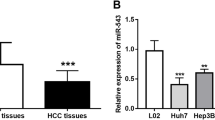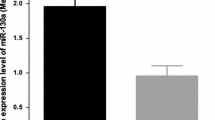Abstract
MicroRNA-372 (miR-372) has been demonstrated to play a crucial role in cellular proliferation and apoptosis of cancer cells. However, its effects in hepatocellular carcinoma (HCC) have not been explored. The aim of this study was to investigate the clinical significance of miR-372 in human HCC. Quantitative RT-PCR was performed to detect miR-372 expression in HCC clinical samples and cell lines. Then, Kaplan–Meier and Cox proportional regression analyses were performed to determine the association of miR-372 expression with survival of HCC patients. Moreover, the effects of miR-372 on tumorigenicity of HCC cell lines were evaluated by in vitro assays. miR-372 expression in HCC tissues was significantly higher than in the corresponding normal adjacent liver tissues (P < 0.001). There was a correlation between miR-372 upregulation and advanced TNM stage of HCC patients (P = 0.02). In addition, HCC patients with higher miR-372 expression had significantly poorer recurrence-free survival (P = 0.006) and overall survival (P = 0.001). Multivariate analysis revealed that high miR-372 expression was an independent predictor of poor prognosis (for recurrence-free survival: Hazard Ratio [HR] 6.826, P = 0.01; for overall survival: HR 9.533, P = 0.008). Moreover, in vitro assays demonstrated that the ectopic expression of miR-372 may significantly promote the cellular proliferation, invasion, and migration of HCC cell lines. Our findings showed that miR-372 may serve as a potent prognostic marker for tumor recurrence and survival of HCC patients. Furthermore, miR-372 has been identified as a promoter for tumorigenicity of HCC cells, suggesting that it might be a prospective therapeutic target for HCC.




Similar content being viewed by others
References
Poon D, Anderson BO, Chen LT et al (2009) Management of hepatocellular carcinoma in Asia: consensus statement from the Asian Oncology Summit 2009. Lancet Oncol 10:1111–1118
Aravalli RN, Steer CJ, Cressman EN (2008) Molecular mechanisms of epatocellular carcinoma. Hepatology 48:2047–2063
El-Serag HB, Rudolph KL (2007) Hepatocellular carcinoma: epidemiology and molecular carcinogenesis. Gastroenterology 132:2557–2576
Barshack I, Meiri E, Rosenwald S et al (2010) Differential diagnosis of hepatocellular carcinoma from metastatic tumors in the liver using microRNA expression. Int J Biochem Cell Biol 42:1355–1362
Villanueva A, Hoshida Y, Toffanin S et al (2010) New strategies in hepatocellular carcinoma: genomic prognostic markers. Clin Cancer Res 16:4688–4694
Negrini M, Gramantieri L, Sabbioni S, Croce CM (2011) microRNA involvement in hepatocellular carcinoma. Anticancer Agents Med Chem 11:500–521
Milazzo M, Fornari F, Gramantieri L (2011) MicroRNA and hepatocellular carcinoma: biology and prognostic significance. Minerva Gastroenterol Dietol 57:257–271
Li D, Liu X, Lin L et al (2011) MicroRNA-99a inhibits hepatocellular carcinoma growth and correlates with prognosis of patients with hepatocellular carcinoma. J Biol Chem 286:36677–36685
Coulouarn C, Factor VM, Andersen JB, Durkin ME, Thorgeirsson SS (2009) Loss of miR-122 expression in liver cancer correlates with suppression of the hepatic phenotype and gain of metastatic properties. Oncogene 28:3526–3536
Li Y, Kowdley KV (2012) Cellular microRNA and the tumorigenesis of hepatocellular carcinoma. Ann Hepatol 11:272–274
Wong CM, Wong CC, Lee JM, Fan DN, Au SL, Ng IO (2012) Sequential alterations of microRNA expression in hepatocellular carcinoma development and venous metastasis. Hepatology 55:1453–1461
Ji J, Zhao L, Budhu A et al (2010) Let-7g targets collagen type I alpha2 and inhibits cell migration in hepatocellular carcinoma. J Hepatol 52:690–697
Nishida N, Goel A (2011) Genetic and epigenetic signatures in human hepatocellular carcinoma: a systematic review. Curr Genomics 12:130–137
Wang B, Majumder S, Nuovo G et al (2009) Role of microRNA-155 at early stages of hepatocarcinogenesis induced by choline-deficient and amino acid-defined diet in C57BL/6 mice. Hepatology 50:1152–1161
Li QJ, Zhou L, Yang F, et al. (2012) MicroRNA-10b promotes migration and invasion through CADM1 in human hepatocellular carcinoma cells. Tumour Biol, In press
Roa W, Brunet B, Guo L et al (2010) Identification of a new microRNA expression profile as a potential cancer screening tool. Clin Invest Med 33:E124
Wang Y, Lee CG (2011) Role of miR-224 in hepatocellular carcinoma: a tool for possible therapeutic intervention? Epigenomics 3:235–243
Voorhoeve PM, le Sage C, Schrier M et al (2006) A genetic screen implicates miRNA-372 and miRNA-373 as oncogenes in testicular germ cell tumors. Cell 124:1169–1181
Cho WJ, Shin JM, Kim JS et al (2009) miR-372 regulates cell cycle and apoptosis of ags human gastric cancer cell line through direct regulation of LATS2. Mol Cells 28:521–527
Yu SL, Chen HY, Chang GC et al (2008) MicroRNA signature predicts survival and relapse in lung cancer. Cancer Cell 13:48–57
Lai JH, She TF, Juang YM et al (2012) Comparative proteomic profiling of human lung adenocarcinoma cells (CL 1–0)expressing miR-372. Electrophoresis 33:675–688
Yamashita S, Yamamoto H, Mimori K et al (2012) MicroRNA-372 Is Associated with Poor Prognosis in Colorectal Cancer. Oncology 82:205–212
Tian RQ, Wang XH, Hou LJ et al (2011) MicroRNA-372 is down-regulated and targets cyclin-dependent kinase 2 (CDK2) and cyclin A1 in human cervical cancer, which may contribute to tumorigenesis. J Biol Chem 286:25556–25563
Acknowledgments
This work was supported by the Science and Technology Development Foundation of China (No. 30900543).
Conflict of interest
None.
Author information
Authors and Affiliations
Corresponding author
Additional information
Jinhui Zhang and Haiyan Zhu authors offer the equal contributions to this study.
Rights and permissions
About this article
Cite this article
Gu, H., Guo, X., Zou, L. et al. Upregulation of microRNA-372 associates with tumor progression and prognosis in hepatocellular carcinoma. Mol Cell Biochem 375, 23–30 (2013). https://doi.org/10.1007/s11010-012-1521-6
Received:
Accepted:
Published:
Issue Date:
DOI: https://doi.org/10.1007/s11010-012-1521-6




